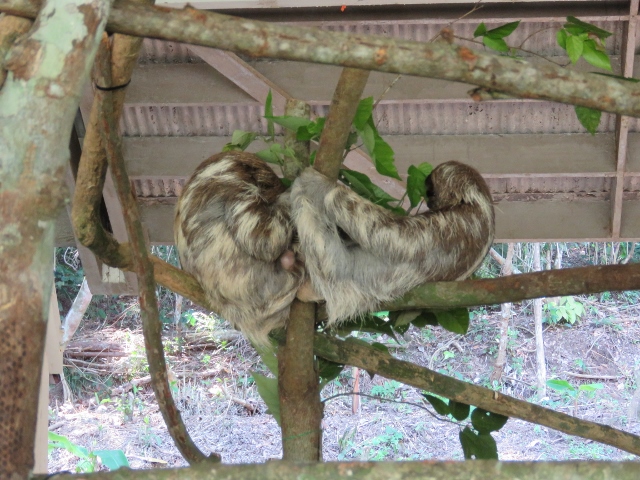Saturday, December 23, 2017, Rain Forest & Aerial Tram, Colon, Panama
We departed Puerto Limon at 6 PM yesterday and arrived Colón, Panama at 8:30 AM today, completing Leg 4 of our cruise.
Colón (Spanish pronunciation: [koˈlon]) is a Panamanian city and sea port beside the Caribbean Sea, lying near the Atlantic entrance to the Panama Canal. It is the capital of Panama's Colón Province and has traditionally been known as Panama's second city. Originally, it was located entirely on Manzanillo Island, surrounded by Limon Bay, Manzanillo Bay, and the Folks River. However since the disestablishment of the Panama Canal Zone, the city's limits have been redefined to include Fort Gulick, a former U.S. Army base, as well the former Canal Zone towns of Cristobal, Margarita, and Coco Solo.
The city was founded by Americans in 1850 as the Atlantic terminal of the Panama Railroad, then under construction to meet the gold rush demand for a fast route to California. For a number of years early in its history, the sizable United States émigré community called the town Aspinwall after Panama Railroad promoter William Henry Aspinwall, while the city's Hispanic community called it Colón in honor of Christopher Columbus. The city was founded on the western end of a treacherously marshy islet known as Manzanillo Island. As part of the construction of the Panama Railroad, the island was connected to the Panamanian mainland by a causeway and part of the island was drained to allow the erection of permanent buildings.
Much of the city was destroyed in the Burning of Colón during the Colombian Civil War of 1885, and again during a massive fire in 1915. The Great Colon Fire of April 13–14, 1940 destroyed one third of the city.
Upon our 8:30 AM arrival today we immediately embarked on our shore excursions. We chose to visit the
where upon we started with an aerial tram ride to the top of a high hill and observation tower.
We enjoyed a bird’s eye view of the lush Gamboa rainforest on board an open-air aerial tram. Panama’s expansive, tropical rainforest is one of the richest, most complex ecosystems in the world. We experienced nature up close as our tram climbs from the shadowy forest floor, through the dense undergrowth, up to the sun-drenched canopy, approximately 280 feet above the ground. A knowledgeable guide accompanied us to describe the tropical plants and local wildlife as we traveled through the treetops. We kept our eyes peeled for a glimpse of the colorful birds and butterflies, white-faced capuchin monkeys and sloths that call the jungle home.
Our tram ride took us thru and over the jungle cover.From the Gamboa Observation Tower, we enjoyed phenomenal aerial views of the Chagres River, Gatun Lake, and the Panama Canal.
From the top of the 90-foot tower, we were able to see the Chagres River, the primary source of the much needed water to operate the Panama Canal locks. The water flows by gravity from upper to lower locks, raising ships as they move to the central passage way and lowering at the other end.
From our high advantage point we were able to see ships on the passage way between the eastern and western (actually the northern and southern) sets of locks.
On our way back down on the tram we spotted a group of 8-10 black monkeys doing what they best do, monkey around in trees!
Look hard at the foto above to see a small red frog; he is an adult about a 1/4 inch long!
The foto above has three green (and black) frog about an inch long and a black frog about 2 inches long.
Next we visited a butterfly pen. There are thousands of butterfly varieties in Panama and Central America.
These bright, blue butterflies are really beautiful. They did not land so we could take photos so these were difficult to take.
The park has a game preserve for sloths. Because they are so vulnerable, many young are left orphans and could not survive without human intervention. One of the young ones had one of its arms amputated, probably due to being run over by a vehicle.
Our last stop in the rain forest was at the orchid nursery. Climate conditions are ideal for these plants and flowers.
Back to Colon we were able to see numerous ships queuing to pass thru the Panama Canal.
We also observed the huge ship yards for loading/unloading cargo container ships.






























Comments
Post a Comment